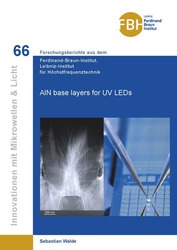| Fachbereiche | |
|---|---|
| Buchreihen (96) |
1378
|
| Nachhaltigkeit |
3
|
| Gesundheitswesen |
1
|
| Geisteswissenschaften |
2364
|
| Naturwissenschaften |
5406
|
| Mathematik | 229 |
| Informatik | 319 |
| Physik | 980 |
| Chemie | 1363 |
| Geowissenschaften | 131 |
| Humanmedizin | 243 |
| Zahn-, Mund- und Kieferheilkunde | 10 |
| Veterinärmedizin | 108 |
| Pharmazie | 147 |
| Biologie | 835 |
| Biochemie, Molekularbiologie, Gentechnologie | 121 |
| Biophysik | 25 |
| Ernährungs- und Haushaltswissenschaften | 45 |
| Land- und Agrarwissenschaften | 1004 |
| Forstwissenschaften | 201 |
| Gartenbauwissenschaft | 20 |
| Umweltforschung, Ökologie und Landespflege | 148 |
| Ingenieurwissenschaften |
1793
|
| Allgemein |
98
|
|
Leitlinien Unfallchirurgie
5. Auflage bestellen |
|
Erweiterte Suche
AlN base layers for UV LEDs (Band 66)
Sebastian Walde (Autor)Vorschau
Leseprobe, PDF (1,2 MB)
Inhaltsverzeichnis, PDF (31 KB)
To enable the fabrication of high performance ultraviolet (UV) light-emitting diodes (LEDs) this work aims at improving the quality of AlN base layers on sapphire substrates. The main issues for UV LEDs are still a limited internal quantum efficiency due to a high amount of threading dislocations along with a limited light extraction efficiency due to total internal reflection at the AlN/sapphire interface. Therefore, high-temperature annealing of AlN/sapphire layers and growth on nanopatterned sapphire substrates were comprehensively investigated.
High-temperature annealing was applied to AlN layers of different strain and thickness grown by metalorganic vapour phase epitaxy (MOVPE). The threading dislocation density could be successfully reduced by more than one order of magnitude down to 6 × 108 cm-2.
Wave optical simulations of UV LEDs on nanopatterned sapphire substrates (NPSS) were conducted and showed a potential increase in light extraction efficiency compared to a planar substrate. The optimized MOVPE growth process on sapphire nanopillars and sapphire nanoholes resulted in a fully coalesced and atomically smooth AlN surface. The threading dislocation density was reduced to 1 ×109 cm-2 for AlN on both nanopillars and nanoholes.
UVC LEDs emitting at 265 nm wavelength were grown on top of the developed templates. Increased internal efficiency was obtained by reduced dislocation density and more efficient light extraction was achieved on NPSS in case of a transparent heterostructure and reflective contacts. Thus, the developed templates yield considerable improvement in light output compared to conventional templates.
| ISBN-13 (Printausgabe) | 9783736974517 |
| ISBN-13 (E-Book) | 9783736964518 |
| Buchendformat | A5 |
| Sprache | Englisch |
| Seitenanzahl | 156 |
| Umschlagkaschierung | matt |
| Auflage | 1. |
| Buchreihe | Innovationen mit Mikrowellen und Licht. Forschungsberichte aus dem Ferdinand-Braun-Institut, Leibniz-Institut für Höchstfrequenztechnik |
| Band | 66 |
| Erscheinungsort | Göttingen |
| Promotionsort | Berlin |
| Erscheinungsdatum | 22.06.2021 |
| Allgemeine Einordnung | Dissertation |
| Fachbereiche |
Physik
Physik der kondensierten Materie (einschließlich Festkörperphysik, Optik) |
| Schlagwörter | AlN, aluminumnitride, AlGaN, aluminumgalliumnitride, base layers, UV LEDs, heteroepitaxy, sapphire, template, light extraction simulations, MOVPE, epitaxy, nanopatterned sapphire substrates, high-temperature annealing, optoelectronics, LEDs, light-emitting diodes, optoelectronic devices, atomic force microscopy, electron channeling contrast imaging, defect-selective etching, electroluminescence, transmission electron microscopy, AlON, nanoholes, nanopillars, threading dislocation density, surface morphology, crystallography, crystal growth, heterostructure, Displacement Talbot Lithography, Nano-imprint lithography, disinfection, internal quantum efficiency, light extraction efficiency, strain, patterned substrates, dislocation analysis, wave optical simulations,AlN, Aluminiumnitrid, AlGaN, Aluminiumgalliumnitrid, Basisschichten, UV-LEDs, Heteroepitaxie, Saphir, Template, Lichtextraktionssimulationen, MOVPE, Epitaxie, nanostrukturierte Saphirsubstrate, Hochtemperaturerhitzen, Optoelektronik, LEDs, lichtemittierende Dioden, optoelektronische Bauteile, Rasterkraftmikroskopie, Electron Channeling Contrast Imaging, defektselektives Ätzen, Elektrolumineszenz, Transmissionselektronenmikroskopie, Oberflächenmorphologie, Kristallographie, Kristallwachstum, Heterostruktur, Displacement Talbot Lithographie, Nanopräge Lithographie, Desinfektion, interne Quanteneffizienz, Lichtextraktionseffizienz, Verzerrung, strukturierte Substrate, Versetzungsanalyse, wellenoptische Simulationen, metallorganische Gasphase, Lichtausbeute, UV-Transparenz, UV transparency, Fadenversetzung, threading dislocation density, Qualitätssteigerung, Versetzungsdichte, Emissionsleistung, AlN-Basisschichten, AlN base layers, Face-to-Face-Konfiguration, Zugspannung, tensile strain, Dehnung |








